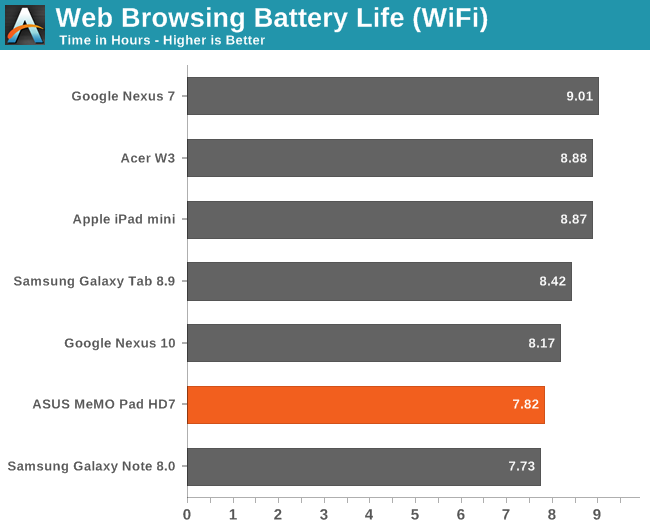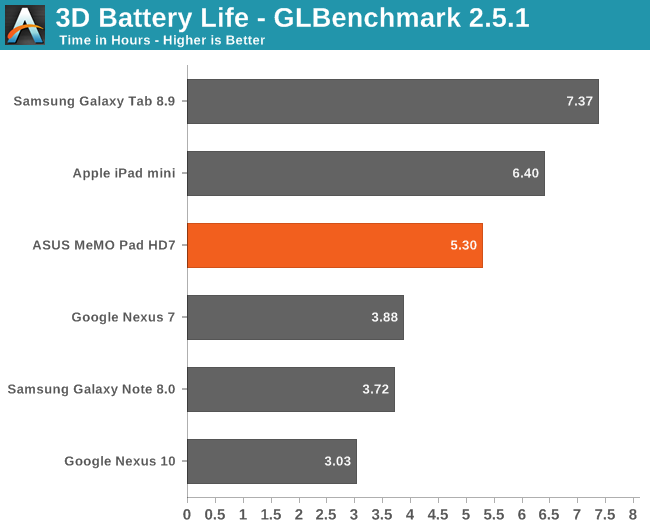ASUS MeMO Pad HD7 Review: $149 Nexus 7.1 Successor & Our First Look at MediaTek's MT8125
by Anand Lal Shimpi on July 29, 2013 3:55 PM EST- Posted in
- Tablets
- Asus
- Mobile
- Android 4.2
- MeMO Pad
Battery Life
The MeMO Pad HD7 includes a 15Wh battery, a ~6% reduction compared to what was in the Nexus 7. The MT8125 SoC on the other hand is likely built on GF's 28nm process, potentially giving it a process advantage over NVIDIA's Tegra 3. There's much more to the platform power consumption story however. Differences in CPU architectures, efficiency of implementation and the surrounding non-CPU IP blocks all play a role in how efficient the MediaTek SoC is.

Normalizing for differences in battery capacity, the MeMO Pad HD7 lasts about 10% less on a single charge than the Nexus 7. Despite being on a lower power process, the MT8125 doesn't seem to be any more power efficient than NVIDIA's Tegra 3. I'm not sure how much of this is a Cortex A7 vs. Cortex A9 thing, and how much of it is the MT8125 just being optimized for cost and not power consumption.

The video playback results are also appreciably lower than the original Nexus 7. I couldn't find any documentation or indication of what video decode IP MediaTek used in the MT8125 but I did notice relatively high CPU utilization during video decode. In the same scenes where Tegra 3's Cortex A9s were running at low utilization/frequencies, I saw 20 - 50% and 1.2GHz on one of the MT8125's A7s.

The one area where the MeMO Pad HD7 ends up more power efficient than the Tegra 3 based Nexus 7 is in our 3D battery life test. Both platforms run Egypt HD at similar performance levels (the T30L Nexus 7 is 15% faster on average), but the MT8125 based MeMO Pad HD7 lasts almost 40% longer. If you normalize for battery capacity, the advantage is even greater. GLB's 3D battery life test has the highest power draw of anything else we run, pointing to idle power optimizations as the biggest problem with the MT8125. What we're seeing here could also be a testament to Imagination Tech's power efficiency advantage over the Tegra 3 GPU.











75 Comments
View All Comments
matt32 - Monday, July 29, 2013 - link
Can you guys run more kinds of WiFi tests on your review devices? Peak throughput is as useful as only showing sequential SSD writes/reads. Can you show how the throughput and latency changes over time especially when there's some sort of interference (ie. microwaves, other WiFi access points, cordless phones, etc.).All too often my Skype calls and Netflix videos get forced into a lower quality whenever my WiFi gets burps. Depending on the device (ie. single atenna vs 3 antennas), the frequency of my WiFi spazzing vairous. Of course, I get the least amount of issues when connected via Ethernet.
Alexvrb - Monday, July 29, 2013 - link
Yeah I don't know what Google's problem is with SD slots. I'd take this thing over the Google-branded hardware.lightsout565 - Monday, July 29, 2013 - link
Very compelling but I'll wait till prices drop to $100. If someone could only make a decent $100 tablet, that'd almost be in "impulse buy" territory for me.Bob Todd - Tuesday, July 30, 2013 - link
I think it's worth noting that the price, although higher than the gen one 16GB Nexus 7 has been since before the iPad mini launch, is actually _cheaper_ than that device when it launched a year ago at $250. Getting a 1200p panel that's also higher quality, a much faster SOC, double the RAM (@1600 vs 1333), much faster storage, and bunch of other little things (rear facing camera, wireless charging, etc.) for $20 less than the 16GB N7 debuted with just one year ago is pretty impressive to me.As for this thing, I actually wish the 8GB model was available here. This looks like the perfect replacement for an old Nook Color that's used to keep a toddler entertained with movies in the car. Especially if it can read SDXC (even if it's the gimped non UHS 1 speed that some devices not rated for SDXC can read them at).
Bob Todd - Tuesday, July 30, 2013 - link
That should read..."noting that the price of the Nexus 7.2".Zibi - Tuesday, July 30, 2013 - link
I've just bought one for my father. Pretty decent thing. Unfortunately it hasn't got USB with OTG. During the brief playing with the thing I did not found the option to create user accounts.SirCanealot - Tuesday, July 30, 2013 - link
Sorry for the possibly silly question, but does anyone know what the cpu monitoring tool used in the screen shot in the battery test is? Looks awesome!skyline159 - Wednesday, July 31, 2013 - link
It is System Monitorhttps://play.google.com/store/apps/details?id=com....
randomhkkid - Tuesday, July 30, 2013 - link
Great article as expected Anand, what is the program you used to overlay the core usage/speed in game?Shadowmaster625 - Tuesday, July 30, 2013 - link
So basically this is what we can expect to pick up for $99 during holidays sales.